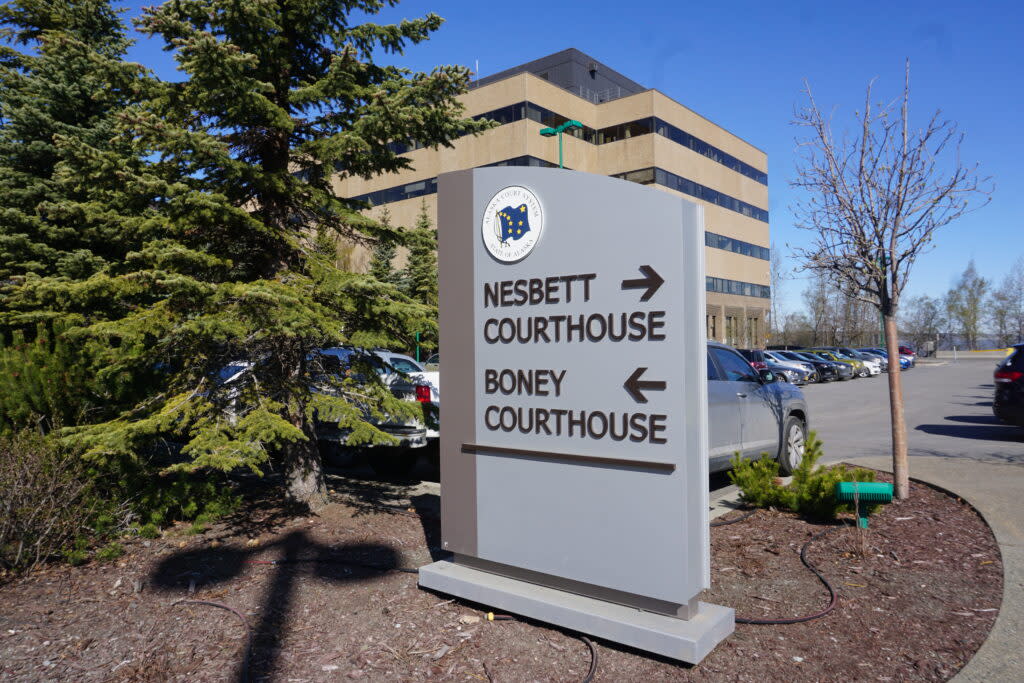Both sides of Alaska homeschool case want programs in place, disagree over how it should happen

The Boney Courthouse in downtown Anchorage, across the street from the larger Nesbett Courthouse, holds the Alaska Supreme Court chambers. (Photo by Yereth Rosen/Alaska Beacon)
The administration of Gov. Mike Dunleavy and plaintiffs in a court case whose outcome struck down key components of Alaska’s homeschool programs have different ideas for how to get families who use those programs through the next year.
Earlier this month, Anchorage Superior Court Judge Adolf Zeman ruled that the law allowing the state to distribute payments to the parents of homeschooled students is unconstitutional. That left families who use the program to navigate uncertain terrain as they finish out this academic year and plan for the next.
For that reason, attorneys on both sides of the case have requested that the courts put the ruling on hold. Such holds are called stays. But where the state has filed for an indefinite stay on the court’s ruling, the plaintiffs ask the court to limit a stay to two months. The Anchorage School District, the state’s largest, filed a friend of the court brief supporting the plaintiffs; three people whose families use the programs filed a response in support of the state.
The state’s request would retain the aspects of Alaska law Zeman found unconstitutional until a higher court weighs in on his decision.
Plaintiffs were willing to compromise, said their attorney, Scott Kendall. They offered to expedite the state’s appeal and help get legislation passed to fix the unconstitutional language in state law. They also offered to agree to the longer stay the state requested if it passed emergency regulations that keep the correspondence program running, but restrict spending on private school education. That is, Alaska families would not be able to offset private school costs with state funds, but could still purchase curriculum and textbooks with state money. Kendall drafted an example of such regulations.
The state declined the plaintiffs’ offer through its attorney.
“At this point, the state plans to see how the stay proceedings play out in the courts, before deciding how best to address any problems that may remain once the trial court and the Supreme Court have weighed in on the stay,” wrote Margaret Paton-Walsh, the chief of the special litigation section within the Alaska Department of Law.
The state’s request for a stay emphasizes the harm correspondence families will experience without one and that the judge’s ruling means correspondence programs would not be able to operate at all.
“For decades, the State has offered correspondence schools as one of the options for Alaskan students in furtherance of its constitutional duty to provide for education,” Paton-Walsh wrote in the stay request. “Wrongfully removing that educational option—even temporarily—irreparably harms both the State’s education system and the children within it.”
Kendall said the state’s argument is disingenuous and that it is clear the ruling does not end the entire correspondence program.
“The only part that they are holding up on is the part that is so clearly unconstitutional,” he said. “I believe they’re trying to manufacture a crisis around the correspondence schools in order to get what they really want, which is to tear out part of our Constitution: the direct benefit clause, which prohibits spending public funds at private schools.”
Kendall said the administration refused a compromise that would maintain the correspondence programs while meeting the constitution’s requirements.
“If that’s where they’re at, then they’re not arguing with me,” Kendall said. “They’re arguing with the founders who wrote Alaska’s constitution, and that’s not a winning legal argument.”
To change the constitution would take approval from two-thirds of both legislative bodies and a public vote in favor.
The state asked for a decision by May 2, but the judge’s decision could come at any time.
GET THE MORNING HEADLINES DELIVERED TO YOUR INBOX
The post Both sides of Alaska homeschool case want programs in place, disagree over how it should happen appeared first on Alaska Beacon.

